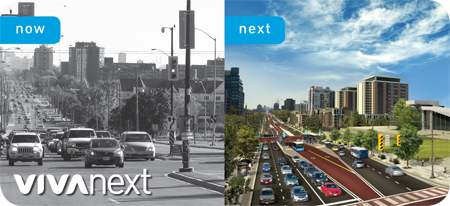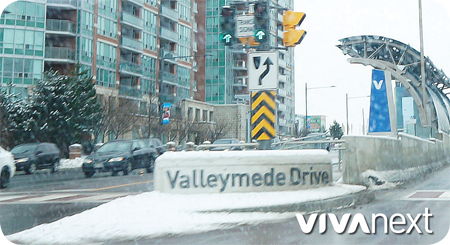
When I first joined the vivaNext team, it was pretty small since we were still at the early stages of our rapid transit program. Now, with an overall team of nearly 78 at York Region Rapid Transit Corporation (YRRTC); and many more staff and experts allocated to the projects through the construction contractors, all these people are working on the vivaNext plan which is going flat out, with planning, procurement, design and construction activities underway concurrently. Here’s the rundown on what we’re doing now, and a preview on some of our other projects you’ll hear more about soon.
The most visible parts of vivaNext – our rapidway construction projects on Highway 7 East and Davis Drive in Newmarket – are definitely a major focus for our team, but they’re only part of what we’ve got going on these days. Moving a major infrastructure project like a rapidway segment forward from the early design stages to the introduction of service requires years of careful planning and oversight, starting with preliminary design and environmental assessments years before construction can start. The same general work plan is currently being followed for the remainder of the Highway 7 rapidway (opening next year) and along Davis Drive in Newmarket. Project management for our active construction projects involves a large part of our team, including engineering, property, finance and communications staff.
In addition, we’re in the early stages of pre-construction for the rapidway on either side of the Vaughan Metropolitan Centre (VMC) on Highway 7, with final design work being completed for the VMC station itself, overtop of the TYSSE concourse for the subway.
At an earlier stage, but already demanding dedicated project teams, is the Yonge Street rapidways in Richmond Hill and Newmarket, and the rapidways that will be built along this major commuter line.
And because a rapid transit network needs more than new lanes, stations and streetscaping, we’ve also got a number of dedicated facilities to plan and build, which will provide the future vivaNext system with more capacity for passengers, bus maintenance, and commuter parking. All of those components are currently under active development, requiring the involvement of project teams with property, design, engineering and financial expertise. Our currently funded projects add up to a total program value of $3.2 billion, which will see us build 37 km of bus rapidways with 38 stations, an 8.6 km subway extension with six stations, an operations facilities, two bus terminals and multiple park ‘n ride facilities over the next five years in York Region.
Last but definitely not least, lots of activity is underway to secure funding for future segments starting with the extension to the Yonge Subway, which is the missing link needed to fully connect the vivaNext system to the broader GTHA transit network.
Everyone at YRRTC works on multiple projects, which allows us to share our knowledge across the program, identify what’s worked well in the past, and ensure that we build on success. Collectively we’ve already amassed a lot of expertise, making design and construction refinements to future projects that reflect what we’ve learned so far.
We all work hard, but the enthusiasm we pick up from the community is so motivating, it’s hard to imagine doing anything more satisfying. We know that with just a few kilometers of rapidway open along the Highway 7 East rapidway, transit travel times have already been reduced and traffic flows improved. So we’re all looking forward to the major improvements that we’ll all get to enjoy, when the whole system is open in a few years from now.
Stay tuned for regular updates throughout 2014, it promises to be a significant year for transit.










